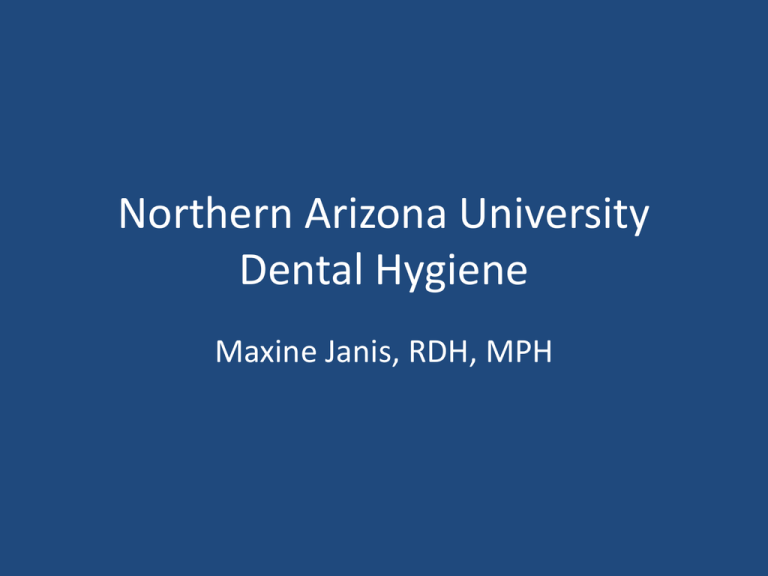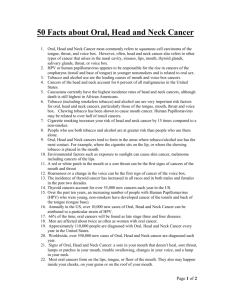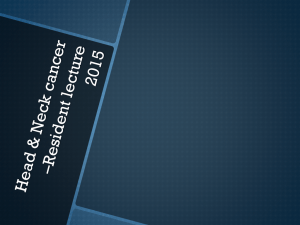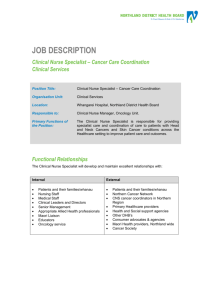
Northern Arizona University
Dental Hygiene
Maxine Janis, RDH, MPH
Oral Cancer
A Public Health Intervention
in
Dental Hygiene Practice
What is Oral Cancer?
• Group of neoplasms (abnormal tissue growth)
that involve of the lip and oral cavity which
can be benign (not cancer) or malignant
(cancer).
• Oral Cavity:
buccal mucosa, gingiva, front or under tongue,
hard palate, and the retromolor region
Oral Cavity and Throat
What is Oral-pharyngeal Cancers?
• Cancers that arise from the back of the throat.
• Base of tongue, palatine tonsils, soft palate,
and posterior pharyngeal wall
• 90 % are squamous cell carcinoma
Robert Hermans Cancer Imaging. 2005; 5(Spec No A): S52–S57. Published online 2005 November 23. doi: 10.1102/1470-7330.2005.0030PMCID: PMC1665316
Head and Neck Cancer Statistics
• 41,000 people diagnosed yearly in the U.S.
• Approximately 12,000 deaths per year
Oral Cancer: Changes in Patterns
• Past risk factors:
Tobacco, alcohol and over 40 yrs of age
• Today risk factors:
HPV –independent risk factor with the
highest incidence among those 18-40 yrs
of age
www.oralcancerfoundation.org www.cdc.gov
Oral Cancer: Changes in Patterns
• 41,000 HAVE HEAD AND NECK CANCERS EACH YEAR: 5065% ARE HPV RELATED
• HPV related incidence has doubled since 1974
(National Cancer Institute)
www.oralcancerfoundation.org www.cdc.gov
At Risk
• Newer demographics emerging in addition to
traditional demographics
1. Age (younger)
2. Non-smokers
3. No excessive alcohol use
Oral Cancer Facts
• Oral cancer is cancer that arises in the head or
neck region, including the nasal cavity,
sinuses, lips, mouth, thyroid glands, salivary
glands, throat or larynx (voice box). According
to the American Cancer Society, an estimated
52,610 new cases of cancer of the oral cavity
and throat, and an estimated 11,500 deaths
from these cancers, are expected in 2012.
Signs and Symptoms
• Most oral cancers arise on the lips, tongue or
the floor of the mouth.
• They also may occur inside your cheeks, on
your gums or on the roof of your mouth.
• Other head and neck cancers arise from the
throat.
Some Signs and Symptoms include:
• A sore in your mouth that doesn't heal or that
increases in size
• Persistent pain in your mouth
• Lumps or white or red patches inside your mouth
• Difficulty chewing or swallowing or moving your
tongue
• Soreness in your throat or feeling that something
is caught in your throat
• Changes in your voice
• A lump in your neck
Risk Factors
• Tobacco (including smokeless tobacco) and alcohol use are the most
important risk factors for oral, head and neck cancers, particularly those of
the tongue, mouth, throat and voice box.
• Eighty-five percent of head and neck cancers are linked to tobacco use.
• People who use both tobacco and alcohol are at greater risk for
developing these cancers than people who use either tobacco or alcohol
alone. (Source: National Cancer Institute).
• Anyone can develop thyroid cancers, although a family history or exposure
to radiation is often a factor.
• Salivary gland cancers do not seem to be associated with any particular
cause.
Human Papillomavirus (HPV) and Oral
Cancer
• Researchers have attributed the increase of
head and neck cancer incidence in young
adults, a group traditionally at low risk, to the
human-papillomavirus (HPV), a cancer-causing
virus that can be transmitted through oral sex.
Human Papillomavirus (HPV) and Oral
Cancer
• Many studies support that oropharyngeal cancers
-- those affecting the tonsils, back of the mouth
(throat) and base of the tongue -- have been on
the rise since the mid-1980s, and currently 50-70
percent of these cases are caused by HPV
infection.
• Many studies show that patients with HPVpositive oropharyngeal cancers are more
responsive to treatment and have better survival
rates than HPV-negative patients.
Oral Cancer
Adjunct Screening Device
Oral Cancer
Adjunct Screening Device
Technology of OC Adjunct Devices
• Emits a safe blue light into the oral cavity, which
excites natural fluorophores from the surface of
the epithelium through to the basement
membrane (where premalignant changes
typically begin) and into the stroma beneath,
causing it to fluoresce.
• The filter makes fluorescence visualization
possible, by blocking reflected blue light, and by
enhancing the contrast between normal and
abnormal tissue.
Pre-clinical discovery
Left palate : low-grade mucoepidermoid carcinoma
SCC
Moderate Dysplasia (cellular
changes precancerous)
Lichen Planus – VELscope Confirmed Benign Etiology
What is OHANCAW?
• Oral, Head and Neck Cancer Awareness Week®
(OHANCAW®) is a weeklong series of events that aim to
educate the public about these potentially life-threatening
but eminently treatable cancers and to promote
prevention, screening and early detection.
• OHANCAW is highlighted by the free screenings and related
activities held at participating medical centers across the
country.
• The screenings are quick, painless, and designed to
advance early diagnosis, which can lead to better
outcomes.
• OHANCAW is sponsored by the Head and Neck Cancer
Alliance (HNCA).
Hopi Men’s Night Out
ORAL CANCER SCREENING Event
When is OHANCAW?
• The primary focus of our media efforts will be
directed toward awareness activities occurring
during this week, but HNCA is encouraging all
supporters to pick a week during the year that
works best for their group to host a free
screening event.
• For more information, go to
www.headandneck.org, e-mail
info@ohancaw.com or call 866-792-4622.
Conclusion
Dental Public Health
• Through intra/extra oral examinations is
critical
• Oral Cancer Screenings
• All lesions must be differentially diagnosed
• Persistent lesions must be biopsied
• Oral Cancer Awareness campaigns to include
tobacco cessation, alcohol use, sexual practice
are critical
Beautiful Mt. Adams
Washington State












